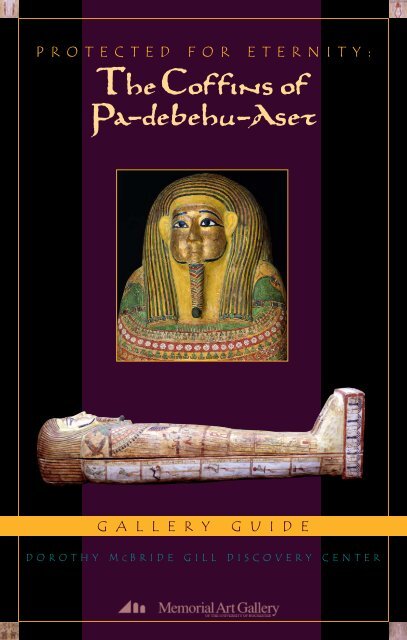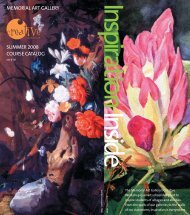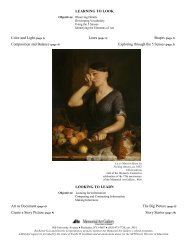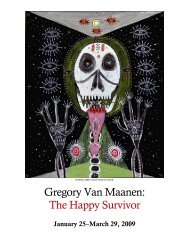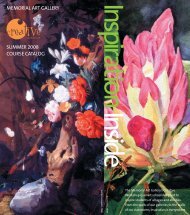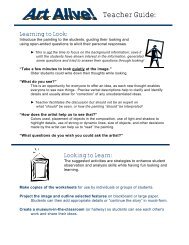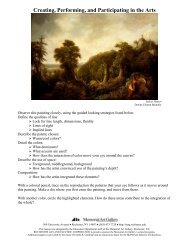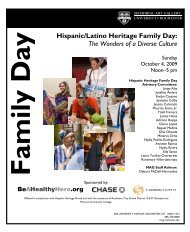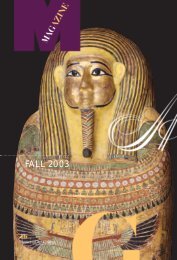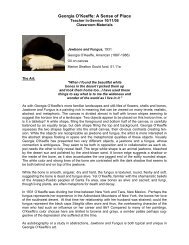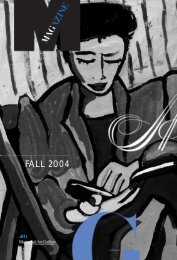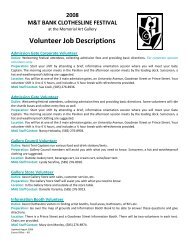The Coffins of Pa-debehu-Aset - Memorial Art Gallery - University of ...
The Coffins of Pa-debehu-Aset - Memorial Art Gallery - University of ...
The Coffins of Pa-debehu-Aset - Memorial Art Gallery - University of ...
Create successful ePaper yourself
Turn your PDF publications into a flip-book with our unique Google optimized e-Paper software.
PROTECTED FOR ETERNITY:<strong>The</strong> <strong>C<strong>of</strong>fins</strong> <strong>of</strong><strong>Pa</strong>-<strong>debehu</strong>-<strong>Aset</strong>G A L L E R Y G U I D EDOROTHY MC BRIDE GILL DISCOVERY CENTER
<strong>The</strong> World <strong>of</strong><strong>Pa</strong>-<strong>debehu</strong>-<strong>Aset</strong>Inside the Gill Discovery Center are two c<strong>of</strong>fins thatwere made for <strong>Pa</strong>-<strong>debehu</strong>-<strong>Aset</strong>, a man who lived anddied in ancient Egypt. He lived in the village <strong>of</strong> Asyut,midway down the River Nile, over 2,300 years ago.Although the world <strong>of</strong> <strong>Pa</strong>-<strong>debehu</strong>-<strong>Aset</strong> may seem longago and far away, we can learn quite a lot about thebeliefs that were important to him and about ancientEgypt in general, by studying the hieroglyphs andsacred symbols on his c<strong>of</strong>fins.Both <strong>of</strong> these c<strong>of</strong>fins were made for<strong>Pa</strong>-<strong>debehu</strong>-<strong>Aset</strong>. <strong>The</strong> anthropoid(human-shaped) c<strong>of</strong>fin once held hismummy. Unfortunately his mummybecame separated from his c<strong>of</strong>finslong ago, and we do not know whereit is, or if it still exists. <strong>The</strong> box-likec<strong>of</strong>fin is called a shrine c<strong>of</strong>fin, andthe anthropoid c<strong>of</strong>fin fits inside it.Only wealthy Egyptians couldafford two c<strong>of</strong>fins.T H I S I S T H EH I E R O G L Y P HFOR:c<strong>of</strong>finA c<strong>of</strong>fin protectedthe mummy fromsun, heat and rain.It also provided aplace to recordsacred prayersand the name <strong>of</strong>the deceased.Egyptian society was divided into distinct socialgroups. <strong>The</strong>re was one pharaoh, usually a king,but sometimes a queen, who ruled over all the land.Pharaohs, and all the members <strong>of</strong> his or her family,were very rich and powerful. Pharaohs were treatedlike gods on earth, and many people helped them intheir daily lives and with running the kingdom.<strong>Pa</strong>-<strong>debehu</strong>-<strong>Aset</strong> was probably a member <strong>of</strong> the uppermiddle class—a social group that also included doctors,engineers, merchants and scribes. MostEgyptians, though, were members <strong>of</strong> the lower classes.<strong>The</strong>y might be soldiers, dancers, farmers, or any<strong>of</strong> a number <strong>of</strong> other occupations.2
Most <strong>of</strong> what we know today about ancient Egypt is aresult <strong>of</strong> the hard work <strong>of</strong> Egyptologists—people whostudy ancient Egypt. <strong>The</strong>y need to learn how to readhieroglyphs so they can study the art and history <strong>of</strong>Egypt, and the objects that survive from that time.<strong>The</strong>y also need to learn about the geography, environmentand politics <strong>of</strong> ancient Egypt, because,like today, those things affect how people live.Try your skill at being an Egyptologist! Locatethis image <strong>of</strong> the god Horus on <strong>Pa</strong>-<strong>debehu</strong>-<strong>Aset</strong>'s shrine c<strong>of</strong>fin. Horus was the son <strong>of</strong> thegod Osiris and the goddess Isis. Here he isshown as a falcon, a type <strong>of</strong> hawk common inancient Egypt.Ancient Egyptians lived in a climate that was bothinviting and extreme. Most <strong>of</strong> the country was dominatedby a harsh, hot and dry desert environment. Fortunately,the land <strong>of</strong> Egypt was also enriched and nourished bythe River Nile, the world's longest river. <strong>The</strong> Nile floodedits banks once every year, leaving behind deposits <strong>of</strong>fertile topsoil, which provided the Egyptians with theironly source <strong>of</strong> rich, workablefarmland.T H I S I S T H EH I E R O G L Y P H¥FORdesertLike most Egyptians,<strong>Pa</strong>-<strong>debehu</strong>-<strong>Aset</strong>lived in a citylocated very nearthe River Nile. In aland that wasmostly desert, itwas important tobe near water.T H I S I S T H EH I E R O G L Y P HFORwater½<strong>The</strong> River Nile wasthe most importantsource <strong>of</strong> freshwater for ancientEgyptians.<strong>The</strong> symbol below is called a wedjat-eye.It is also known as “the eye <strong>of</strong> Horus.” It is avery powerful symbol <strong>of</strong> rebirth and protection,and it will be your clue to explore the Gill Centeras you test your knowledge <strong>of</strong> ancient Egypt!Find <strong>Pa</strong>-<strong>debehu</strong>-<strong>Aset</strong>'s city <strong>of</strong>Asyut on the map.Turn the page to explorethe remarkable world <strong>of</strong><strong>Pa</strong>-<strong>debehu</strong>-<strong>Aset</strong>…3
T H I S I S T H E G O DOsirisSacred StoriesLike all ancient Egyptians, <strong>Pa</strong>-<strong>debehu</strong>-<strong>Aset</strong> worshippedhundreds <strong>of</strong> gods and goddesses. <strong>The</strong>y helped him livehis life on earth and prepare for eternal life after death.In the ancient Egyptian creation story, the world beganwith Nun, the raging waters <strong>of</strong> chaos. <strong>The</strong> sun god Reemerged from Nun and created Shu, god <strong>of</strong> the air,and Tefnut, goddess <strong>of</strong> the morning dew. Shu and Tefnutthen created Geb, god <strong>of</strong> the earth, and Nut, goddess<strong>of</strong> the sky. <strong>The</strong>se deities created all the other godsand goddesses.This is an image<strong>of</strong> Nut, thegoddess <strong>of</strong> thesky. She is alsothe mother <strong>of</strong>the gods Osirisand Seth.T H I S I S T H EG O D D E S SNephthysFind Nut on <strong>Pa</strong>-<strong>debehu</strong>-<strong>Aset</strong>’santhropoid c<strong>of</strong>fin.A grandson <strong>of</strong> the god Re, Osiris was the most powerfulEgyptian god. He was originally a god <strong>of</strong> agricultureand fertility, and the first pharaoh <strong>of</strong> Egypt. He wastricked and killed by his evil brother Seth, the god <strong>of</strong> thestorm, chaos and the desert. Seth tore Osiris' body intomany pieces and scattered them throughout Egypt.Osiris' wife Isis and her sister Nephthys searched tirelesslyuntil they gathered together all the pieces <strong>of</strong>Osiris' body. Anubis, the god <strong>of</strong> mummification, put allthe pieces <strong>of</strong> Osiris' body back together and wrappedhis body in linen. Anubis magically reunited Osiris' spiritwith his mummified body, and Osiris began a new lifeas the god <strong>of</strong> the Underworld.4
Isis and Nephthys are sisters,and they are <strong>of</strong>ten difficult to tellapart. <strong>The</strong> one difference is theheaddress each wears—Isisusually wears a headdress in theshape <strong>of</strong> a throne or a sundiskwith horns; Nephthys usuallywears a headdress with a picture<strong>of</strong> a palace topped by a basket.T H I S I S T H EG O D D E S SIsisFind the two sisters togetheron <strong>Pa</strong>-<strong>debehu</strong>-<strong>Aset</strong>'s anthropoidc<strong>of</strong>fin. Which one is which?T H I S I S T H E G O DHorus<strong>Pa</strong>-<strong>debehu</strong>-<strong>Aset</strong> would have relied on Osiris, Isis,Nephthys, Horus and Anubis for protection from harm.If <strong>Pa</strong>-<strong>debehu</strong>-<strong>Aset</strong> had a family, he and his wife wouldhave asked the god Bes and the goddess Taweret—both important household gods—to help keep themsafe and healthy.Bes was the god <strong>of</strong> the home, childbirth, infants, humor,song and dance. Along with Taweret, he was one <strong>of</strong> the mostimportant household gods because he warded <strong>of</strong>f evil spiritsfrom newborns at the moment <strong>of</strong> birth. He is always shownas half-lion, half-man. Taweret protected mothers and theirchildren against the many risks surrounding pregnancy andchildbirth. She is always shown as a pregnant hippopotamuswith the limbs and paws <strong>of</strong> a lion.Find Bes and Taweret. Look carefully—in thisexhibit they are represented as amulets—small charms carried or worn for protectionor rebirth.Most <strong>of</strong> the important gods and goddesses are namedand pictured on <strong>Pa</strong>-<strong>debehu</strong>-<strong>Aset</strong>'s two c<strong>of</strong>fins. AncientEgyptians believed their powerful presence protectedthe deceased throughout eternity. Look around the GillDiscovery Center for clues to help you identify “Who'sWho” on the c<strong>of</strong>fins.Turn the page to learn about how mummies are made…See howmany godsandgoddessesyou canrecognize!5
T H I S I S T H E G O DAnubisas a jackalheadedmanHow a Mummy isMadeUnfortunately, <strong>Pa</strong>-<strong>debehu</strong>-<strong>Aset</strong>'s mummy is missing.However, we know his body was mummified, and thenplaced inside his anthropoid c<strong>of</strong>fin because a fragment<strong>of</strong> linen and some small decorative beads thatonce adorned his body remain inside the c<strong>of</strong>fin. <strong>The</strong>ancient Egyptians took great care to preserve a person'sbody after death. <strong>The</strong>y believed both the ka,a person's spirit double, and the ba, a person's eternalsoul, needed to return to the body in the next world.T H I S I S T H E G O DAnubisas a jackalThis is Isis, the goddess <strong>of</strong> mourning.She was the wife <strong>of</strong> Osiris,and assisted Anubis with mummification.Look at the position <strong>of</strong> herarms—they are in the same positionas the hieroglyph for ka, whichis written as K. <strong>The</strong> hieroglyphfor ba is written as a ba-bird, likethis Ö.Find Isis on<strong>Pa</strong>-<strong>debehu</strong>-<strong>Aset</strong>'sshrine c<strong>of</strong>fin.After someone died, the bodywas taken to an embalmer—a specialist trained in mummification. AncientEgyptians believed the brain wasn’t important, so itwas removed and discarded. <strong>The</strong> heart was treatedwith great care, as it was believed to be the center <strong>of</strong>intelligence. It was removed, wrapped separately andreturned to its place in the body. <strong>The</strong> lungs, liver, stomachand intestines were removed, individuallyembalmed, and placed in canopic jars.6
<strong>The</strong> humanheadedgodImsety guardedthe liver<strong>The</strong> jackalheadedgodDuamutef wasin charge <strong>of</strong> thestomach<strong>The</strong> baboonheadedgodHapi watchedover the lungs<strong>The</strong> falconheadedgodQebhsenuefprotected theintestinesCanopic jars were specialcontainers that held theembalmed internal organs<strong>of</strong> a dead person. Each jarheld a specific organ, andeach lid shows <strong>of</strong> one <strong>of</strong> thefour sons <strong>of</strong> the god Horus.Once the organs were removed, the body was coveredwith a special salt called natron that removed allthe moisture. After about 40 days, the body was driedand ready to be wrapped in hundreds <strong>of</strong> yards <strong>of</strong>linen strips. (Try to picture strips <strong>of</strong> cloth the length <strong>of</strong>several soccer fields laid end to end!). Fingers werebandaged individually; then the arms and legs werewrapped separately before being wrapped togetherwith the rest <strong>of</strong> the body. <strong>The</strong> head was wrapped last.Priests were present during the wrapping process, andthey said special prayers as they inserted amuletsbetween the linen strips. <strong>The</strong> entire process <strong>of</strong> preparingthe mummy could take up to 70 days.Anubis was the god <strong>of</strong>mummification. AncientEgyptians believed heguided the process <strong>of</strong>mummification. He isalways shown as a jackal—a type <strong>of</strong> wild dog—or a jackal-headed man.Find Anubis on <strong>Pa</strong>-<strong>debehu</strong>-<strong>Aset</strong>’santhropoid c<strong>of</strong>fin.Turn the page to learn about <strong>Pa</strong>-<strong>debehu</strong>-<strong>Aset</strong>'s journeyto the afterlife…T H I S I S T H EH I E R O G L Y P HFORmummySUsually Egyptiansdrew the humanbody with botharms and legs infull view. But herethe body is shownall wrapped up—just the way amummy shouldlook!T H I S I S T H E-H I E R O G L Y P HFORintestine<strong>The</strong> ancientEgyptians learneda great deal aboutthe human bodythrough theprocess <strong>of</strong>embalming andmummification.7
T H I S I S T H EH I E R O G L Y P HFORdjed–pillar©This sign <strong>of</strong> Osirissignifies stabilityand representshis backbone.T H I S I S T H EH I E R O G L Y P HFORlifeåIt is called anankh sign andcan be foundmany times onboth c<strong>of</strong>fins.Journey to theAfterli feAfter the body was mummified, it was placed in ac<strong>of</strong>fin—or like <strong>Pa</strong>-<strong>debehu</strong>-<strong>Aset</strong>'s mummy—a set <strong>of</strong>nesting c<strong>of</strong>fins. A funeral procession was held thatincluded friends and family members <strong>of</strong> the deceased,as well as musicians and dancers. <strong>The</strong> c<strong>of</strong>fins werethen placed in a tomb with gifts such as food, furniture,jewelry and many other items that would make lifecomfortable for the deceased in the next world.This is a funeralprocession inancient Egypt.On the far left isthe god Anubis,shown as ajackal. In front <strong>of</strong> him, a group <strong>of</strong> male mourners followthe anthropoid c<strong>of</strong>fin <strong>of</strong> the deceased. <strong>The</strong> wife <strong>of</strong> thedeceased kneels in front <strong>of</strong> her husband's c<strong>of</strong>fin. Thisimage is from the Book <strong>of</strong> the Dead, a collection <strong>of</strong>hymns, prayers and spells that were written onpapyrus and placed inside the c<strong>of</strong>fins or on themummy itself.<strong>The</strong> ancient Egyptians enjoyed their life on earth, andthey believed in an afterlife that lasted for eternity.According to ancient Egyptian beliefs, after <strong>Pa</strong>-<strong>debehu</strong>-<strong>Aset</strong>was mummified and buried in a tomb, his soulbegan a journey into the next world. This journey wasdifficult and risky, but the sacredsymbols and hieroglyphs on his twoc<strong>of</strong>fins <strong>of</strong>fered his spirit assistanceand protection.Egyptologists have deciphered thehieroglyphs on <strong>Pa</strong>-<strong>debehu</strong>-<strong>Aset</strong>'sc<strong>of</strong>fins. One prayer from the top <strong>of</strong>the shrine c<strong>of</strong>fin appears at left...8
...And here is what it says:“1,000 jugs <strong>of</strong> beer, 1,000 oxen, 1,000 fowl, 1,000 <strong>of</strong>every good and pure thing for the ka <strong>of</strong> the veneratedone, the Osiris, <strong>Pa</strong>-<strong>debehu</strong>-<strong>Aset</strong>.”Bread and beer were an important part <strong>of</strong> mostancient Egyptians’ diet. Even so, one thousand loaves<strong>of</strong> bread and one thousand jugs <strong>of</strong> beer would feedone person for a long time. This prayer meant that thedeceased would have food and drink for eternity. Italso asked that <strong>Pa</strong>-<strong>debehu</strong>-<strong>Aset</strong> be given “1,000 <strong>of</strong>every good and pure thing” once he reached eternity.What “good and pure things” do you think he wouldhope to receive?T H I S I S T H EH I E R O G L Y P HFORscarab¡<strong>The</strong> scarab beetlewas a symbol <strong>of</strong>the rising sun andrebirth.<strong>The</strong> ancient Egyptians wanted to enjoy eternitywithout working too hard, so they includedshawabti figures in their tombs. <strong>The</strong>se smallmodels <strong>of</strong> human beings acted as substituteworkers for the deceased. If any plantingor harvesting was required <strong>of</strong> the deceased,the shawabti figure would magicallyperform the task in their place.Sometimes as many as 365 shawabtifigures—one for each day <strong>of</strong> the year—would beincluded ina tomb. Andsometimesthey wereplaced in aspecialshawabtibox like thisone.0T H I S I S T H EH I E R O G L Y P HFORsunThis solar diskwas also a sign <strong>of</strong>the sun god Re.Find these two objects in theGill Discovery Center.Turn the page to learn about reading and writingin ancient Egypt…9
T H I S I S T H EH I E R O G L Y P HFORpapyrusÊ<strong>Pa</strong>pyrus grewalong the banks <strong>of</strong>the River Nile.Reading andWriting inAncient EgyptMost people in ancient Egypt could not read andwrite. That skill was learned and practiced by a smallnumber <strong>of</strong> people called scribes. Scribes were importantand respected members <strong>of</strong> Egyptian society.<strong>The</strong>y trained for many years,beginning around the age <strong>of</strong> nine.T H I S I S T H EH I E R O G L Y P HF O R T H E G O DThothHere Thothappears in theform <strong>of</strong> an ibis.10”This is Thoth, the god <strong>of</strong> scribes,wisdom, and the moon. He isshown here with the body <strong>of</strong> a manand the head <strong>of</strong> an ibis—a belovedbird to the ancient Egyptians.Find Thoth on<strong>Pa</strong>-<strong>debehu</strong>-<strong>Aset</strong>'sshrine c<strong>of</strong>fin.<strong>The</strong> ancient Egyptians used acomplicated system <strong>of</strong> writing called hieroglyphs.Hieroglyphs were symbols that represented sounds,ideas, people or objects found in ancient Egyptian life.Sometimes they were painted on wood or papyrus—a type <strong>of</strong> paper made from the papyrus plant—andsometimes they were carved into stone. <strong>The</strong>re wereover 700 different hieroglyphic signs. Imagine trying tolearn that many!ÅThis is the hieroglyph for a scribe's toolkit. Itshows the container that holds one circularcake <strong>of</strong> red ink, and another <strong>of</strong> black. <strong>The</strong>hieroglyph also includes pictures <strong>of</strong> a smallwater jar and a brush used for writing.When you combine the hieroglyph for a“scribe's toolkit” with the hieroglyph for“man,” you get the hieroglyph for “scribe.”ÅÍ
Hieroglyph is a Greek word that means “sacred carving.”Sometimes hieroglyphs really look like the wordsthey represent. For example, look at the four hieroglyphsbelow and try to guess what they mean:ˆ G [ oBut sometimes they can be pretty tricky! Try to guesswhat these four hieroglyphs mean:r 0 H †T H I S I S T H EH I E R O G L Y P HFORfriendbThis sign is verysimilar to the ankhsign, whichsymbolizes “life”.(<strong>The</strong> answers are at the bottom <strong>of</strong> this page.)Now look closely at the hieroglyphs below.Can you find them on <strong>Pa</strong>-<strong>debehu</strong>-<strong>Aset</strong>’sc<strong>of</strong>fin?v n •horned viper ripple <strong>of</strong> water star<strong>Pa</strong>-<strong>debehu</strong>-<strong>Aset</strong>'s nameappears many times onboth <strong>of</strong> his c<strong>of</strong>fins.His namemeans “theone whowas arequest <strong>of</strong>the goddessIsis.”It is writtenlike this:And this is the way itappears on the lid <strong>of</strong> hisanthropoid c<strong>of</strong>fin:Can you find<strong>Pa</strong>-<strong>debehu</strong>-<strong>Aset</strong>'s nameon hisc<strong>of</strong>fins?T H I S I S T H EH I E R O G L Y P HFORstrengthrDo you recognizethe head on thestaff? (It's Anubis,the god <strong>of</strong> mummification.)<strong>The</strong> ancient Egyptians believed that as long as theyrepeated the name <strong>of</strong> someone who died, that personwould continue to live on in eternity. You can helpkeep the spirit <strong>of</strong> <strong>Pa</strong>-<strong>debehu</strong>-<strong>Aset</strong> alive by saying hisname out loud (pah-deh-beh-HOO-AH-seht), andlearning more about his world.cup, tree, sunshine, turtlemouth, seat, garden, heart11
GlossaryamuletsanthropoidAnubisbaBescanopic jarsDuamutefHapihieroglyphsHorusibisImsetyIsiska(AM-yoo-lets): small charmsworn or carried for protection orrebirth; worn as jewelry in lifeand also tucked into linenmummy wrappings(ANN-throw-poyd): shaped likea person(ah-NOO-bis): god <strong>of</strong>mummification(bah): eternal, imperishablesoul that <strong>of</strong>ten takes the form <strong>of</strong>a human-headed bird(bess): household god whoprotected infants from evil;appears as half-lion, half-man(can-OH-pick): a set <strong>of</strong> fourlidded jars intended to hold theliver, lungs, stomach andintestines(doo-AH-moo-tehf): one <strong>of</strong> thefour sons <strong>of</strong> the god Horus;canopic protector <strong>of</strong> the stomach;has the head <strong>of</strong> a jackal(HAH-pea): one <strong>of</strong> the foursons <strong>of</strong> the god Horus; canopicprotector <strong>of</strong> the lungs; has thehead <strong>of</strong> a baboon(HIGH-row-GLIFS): “sacredcarvings;” a writing system thatcombines symbols representingsounds, ideas, people orobjects found in ancient Egypt(HOR-uhs): the son <strong>of</strong> the godOsiris and the goddess Isis, herepresents the power <strong>of</strong> theruling pharaoh(EYE-bis): native Egyptian birdwith long legs and a curvedbill; represents the god Thoth(im-SET-ee): one <strong>of</strong> the foursons <strong>of</strong> the god Horus; canopicprotector <strong>of</strong> the liver; has thehead <strong>of</strong> a man(EYE-sis): a goddess <strong>of</strong>mourning, she was the wife <strong>of</strong>the god Osiris, mother <strong>of</strong> thegod Horus and sister <strong>of</strong> thegoddess Nephthys(kah): divine, spiritual doubleor “twin,” born with a personand returns to the spirit worldafter deathlinenmummificationnatronNephthys(LIH-nin): cloth made from theflax plant; used for clothing andmummy wrappings in ancientEgypt(MUM-mi-fa-KAY-shun): theprocess <strong>of</strong> drying out and preservinga body after death(NAY-tron): natural salt used inthe mummification process(NEP-this): a goddess <strong>of</strong>mourning and sister <strong>of</strong> thegoddess IsisC R E D I T S :This <strong>Gallery</strong> Guide is made possible by Dan and Dorothy Gill, with additional funding from the ,a state program <strong>of</strong> the National Endowment for the Humanities.All objects are owned by the <strong>Memorial</strong> <strong>Art</strong> <strong>Gallery</strong> <strong>of</strong> the <strong>University</strong> <strong>of</strong> Rochester with the exception <strong>of</strong> the following objects: amulets(page 5); shawabti figure and shawabti box (page 9), Peabody Essex Museum, Salem, Massachusetts; canopic jars (page 7), <strong>The</strong>Metropolitan Museum <strong>of</strong> <strong>Art</strong>, Gift <strong>of</strong> James Douglas, 1890. (90.6.31ab, .32ab, .33ab, .34ab) Photograph © 2003 <strong>The</strong> Metropolitan Museum<strong>of</strong> <strong>Art</strong>; <strong>The</strong> Egyptian Book <strong>of</strong> the Dead (page 8), copyright 1994,1998 James Wasserman, Chronicle Books, www.book<strong>of</strong>dead.com.NutOsiris(nuht): goddess <strong>of</strong> the sky(oh-SIGH-riss): the god <strong>of</strong> theUnderworld, husband <strong>of</strong> thegoddess Isis and father <strong>of</strong> thegod Horus<strong>Pa</strong>-<strong>debehu</strong>-<strong>Aset</strong> (pah-deh-beh-HOO-AH-seht): aman who lived in ancient Egypt2,300 years ago. His namemeans “the one who was arequest <strong>of</strong> the goddess Isis”papyruspharaohQebsenuefscribeshawabtishrine c<strong>of</strong>finTaweretThoth(pah-PIE-ruhs): a tall reed-likemarsh plant used for making apaper-like material for writingand record-keeping(FAIR-oh): title for kings inancient Egypt(kehb-SEH-noo-ehf): one <strong>of</strong> thefour sons <strong>of</strong> the god Horus;canopic protector <strong>of</strong> the intestines;has the head <strong>of</strong> a hawk(skribe): well-educated <strong>of</strong>ficialswho learned and practicedhieroglyphic writing(shah-WAHB-tee): small mummiformfigures buried in tombsto act as helpers, workers andservants in the afterlife(shrine COF-in): a rectangularouter c<strong>of</strong>fin that holds ananthropoid c<strong>of</strong>fin, shaped likethe shrine <strong>of</strong> a god(tah-WHERE-et): householdgoddess <strong>of</strong> childbirth and children;appears as a pregnanthippopotamus with the limbsand paws <strong>of</strong> a lion(thohth): god <strong>of</strong> scribes,wisdom, and the moon


